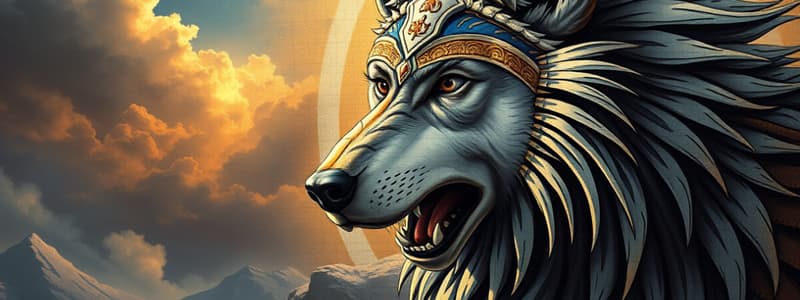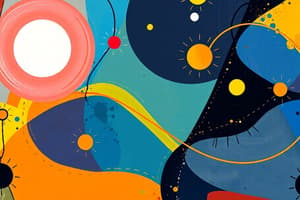Podcast
Questions and Answers
What was the primary purpose of paintings from the Prehistoric Era?
What was the primary purpose of paintings from the Prehistoric Era?
- To serve as religious icons
- To communicate with others (correct)
- To showcase wealth and power
- To represent daily life
Which characteristic is most commonly associated with Greek Art?
Which characteristic is most commonly associated with Greek Art?
- Focus on realism and idealized forms (correct)
- Rejection of human figures in sculpture
- Use of bright colors and abstract designs
- Emphasis on religious themes and rituals
What aspect of art does Egyptian Art primarily emphasize?
What aspect of art does Egyptian Art primarily emphasize?
- Naturalistic representation of the human form
- Landscape painting and perspective
- Dynamic movement and emotion in figures
- Symbolism and afterlife imagery (correct)
Which influence is well known in Romanesque Art?
Which influence is well known in Romanesque Art?
Which style of art flourished during the height of the Byzantine Empire and focused on Christian themes?
Which style of art flourished during the height of the Byzantine Empire and focused on Christian themes?
What was a common feature of Romanesque churches?
What was a common feature of Romanesque churches?
Which art form in Byzantine culture was heavily influenced by earlier Greek and Egyptian techniques?
Which art form in Byzantine culture was heavily influenced by earlier Greek and Egyptian techniques?
What characterizes the painting style in Romanesque art?
What characterizes the painting style in Romanesque art?
What element is NOT typically associated with Gothic art?
What element is NOT typically associated with Gothic art?
The Capitoline Wolf sculpture is particularly significant as it depicts what?
The Capitoline Wolf sculpture is particularly significant as it depicts what?
How did Roman mosaics typically differ from other art forms?
How did Roman mosaics typically differ from other art forms?
What is a notable characteristic of Greek art that impacted later periods?
What is a notable characteristic of Greek art that impacted later periods?
What is a notable feature of Greek sculpture during the Hellenistic period?
What is a notable feature of Greek sculpture during the Hellenistic period?
Which technique did Roman artists utilize to create the illusion of depth?
Which technique did Roman artists utilize to create the illusion of depth?
What defines the architectural style of the Temple of Poseidon at Paestum?
What defines the architectural style of the Temple of Poseidon at Paestum?
Which element is NOT typically representative of Gothic art?
Which element is NOT typically representative of Gothic art?
What is a characteristic of folk art as mentioned in the content?
What is a characteristic of folk art as mentioned in the content?
What does the term 'naturalist representation' refer to in art?
What does the term 'naturalist representation' refer to in art?
Which feature was commonly present in ancient Egyptian art?
Which feature was commonly present in ancient Egyptian art?
What is a distinct characteristic of Roman architecture observed in the Maison Carree?
What is a distinct characteristic of Roman architecture observed in the Maison Carree?
Study Notes
The Grand Hunt
- Capitoline Wolf: Bronze sculpture depicting a she-wolf nursing Romulus and Remus, symbolizes the founding legend of Rome.
Folk Art
- Roman Mosaic: Ranges from abstract black-and-white designs to vibrant multi-colored figurative compositions.
Byzantine Art
- Flourished during the Byzantine Empire, focusing mainly on Christian themes while incorporating Greek and Egyptian artistic techniques.
Architecture
- Byzantine architecture influenced various structures, characterized by domes and extensive decorative elements.
Painting
- Byzantine painting emphasized religious figures with flat, gold backgrounds, providing a spiritual yet two-dimensional appearance.
Carving and Mosaic
- Carving and mosaic art also reflected Byzantine influences, showcasing intricate designs and religious motifs.
Romanesque Art
- Architecture: Romanesque churches featured massive forms and thick walls, with decorative arcades and sculptural reliefs.
- Painting: Mixed classical inspiration with a new energetic drawing style, exhibiting heightened emotional expression.
Greek Art (1,050 BC - 31 BC)
- Architecture: The Temple of Poseidon in Paestum, Italy, represents mid-5th century BC classical architecture.
- Painting: Frescoes in Paestum displayed advanced knowledge of human anatomy and dynamic compositions, depicting battle scenes, mythological figures, and daily life.
- Sculpture: Notable for idealized forms, epitomized by the Venus de Milo, symbolizing Hellenistic beauty.
- Folk Art: Early pebble mosaics used stones set in mortar, which adorned household floors.
Roman Art
- Architecture: The Maison Carrée temple in Nîmes, France, expanded to include an outer portico, symbolizing Roman architectural advancements.
- Painting: Roman artists utilized aerial perspective to create an illusion of depth, enhancing realism in their artworks.
Overview of Western Classical Art Tradition
- Includes various eras such as Pre-Historic, Egyptian, Greek, Roman, Byzantine, Romanesque, and Gothic art, highlighting the evolution of artistic expression through history.
Pre-Historic Era
- Cave Paintings: Found in the Lascaux caves (15,000-10,000 BC), depicted large regional animals, serving as early communication or ceremonial expressions.
- Caves were discovered on September 12, 1940, receiving protection as ancient monuments, emphasizing their historical significance.
Studying That Suits You
Use AI to generate personalized quizzes and flashcards to suit your learning preferences.
Related Documents
Description
Explore the significance of the Capitoline Wolf and the diverse styles of Roman mosaics through this quiz. Delve into the intricate details and historical context of these iconic artworks that reflect the richness of Western art traditions.




